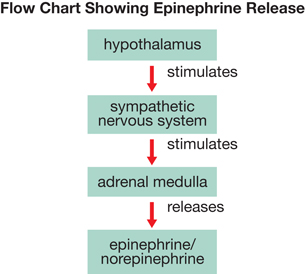Module 2
1. Module 2
1.22. Page 3
Module 2—The Endocrine System
The Adrenal Medulla—Regulating Short-Term Stress
 Read
Read

© John Bell/shutterstock
In Module 1 you studied sympathetic nerve activity, which is collectively called the fight-or-flight responses. These responses prepare the body for immediate action. To refresh your memory and summarize what these responses are, read “The Autonomic System” on page 397 and “The Adrenal Medulla: Regulating the Short-Term Stress Response” on page 452 and the top of page 453 in your textbook.
Nerve impulses from the sympathetic nervous system stimulate the adrenal medulla to release epinephrine and norepinephrine. These hormones circulate in the bloodstream and enhance the activities of the sympathetic nervous system. Together, the sympathetic nervous system and the release of hormones from the adrenal medulla provide the resources (oxygen and blood glucose) for energy release by aerobic cellular respiration and allow the body to perform far beyond its capacity. You may have heard stories of how a mother fearlessly fought off a bear that was mauling her child or how a man lifted a car to free an accident victim pinned beneath it. These incredible feats were performed because the sympathetic nervous system stimulated the adrenal medulla to release a burst of adrenaline, which enabled a lot of energy to be released by metabolism.
fight-or-flight response: a short-term stress response that ensures increased amounts of glucose and oxygen are available to muscle cells for cellular respiration, which results in increased available energy for use by muscles
epinephrine: a hormone produced by the adrenal medulla in response to stress; also called adrenaline
The adrenal gland produces about 80% epinephrine and 20% norepinephrine.
norepinephrine: a second hormone produced by the adrenal medulla in response to stress, but in much smaller quantities than epinephrine
About 20% of adrenal medulla secretions are norepinephrine.
Use the information on page 452 of your textbook to make notes about the adrenal medulla, or prepare a flow chart similar to “Figure 13.21” on page 452. You may also choose to make summary notes from the following video segments.
 Watch and Listen
Watch and Listen
The following segments of “The Adrenal Glands and the Gonads: Stress and Sexuality: Vital to Life” will reinforce your understanding of how the adrenal medulla works to combat the effects of what is sometimes called short-term stress. You may be required to enter a username and password to access these videos. Contact your teacher for this information.
- “Epinephrine Release”
- “Bio Quest: Fight-or-Flight”
- “Bio Discovery: Body Responses to Epinephrine”
- “Symptoms of Stress”
 Self-Check
Self-Check
To review the concepts of the short-term stress response, complete the following questions. After checking your answers, file them in your course folder.
SC 1. Describe a “fight” response and a “flight” response, and include the biological mechanism behind these responses.
SC 2. Identify three groups of stress stimuli (categories of things that cause stress).
SC 3. Explain how the hypothalamus is involved in the release of epinephrine and norepinephrine by the adrenal medulla. You may choose to use a flow chart to illustrate your response.
 Self-Check Answers
Self-Check Answers
SC 1. The short-term responses to stress are commonly referred to as the fight-or-flight responses. Like the nerve impulses of the sympathetic nervous system, the hormones of the adrenal medulla prepare the body to fight or flight by increasing the levels of oxygen and glucose and their distribution to the muscles and tissues. To increase the level of oxygen in the blood, the breathing rate increases and the bronchioles dilate go get more oxygen into the lungs for diffusion. To increase the level of glucose in the blood, the liver and muscles are stimulated to convert stored glycogen into glucose. Heart rate, cardiac output, and blood pressure all increase so that distribution of the blood to the tissues is greater and faster. Peripheral blood vessels (in the skin) and those to the digestive system constrict and redirect blood to the muscles and tissues that need more blood. Cellular respiration is increased and releases more energy to deal with the situation or to quickly run away. In addition, sweating increases to deal with the extra heat produced from increased metabolism (cellular respiration) and the pupils dilate so more light enters the eyeball and increases visual acuity so that the danger can be seen more clearly.
SC 2. Three groups of stress stimuli may be infection; injury to the body; or emotional stimuli, such as fear, anger, or extreme sadness.
SC 3. The adrenal medulla is composed of modified neurons. Neurons from the sympathetic nervous system of the autonomic nervous system, whose centres are located in the hypothalamus, directly stimulate the cells of the adrenal medulla to produce epinephrine and norepinephrine. This can also be explained with a flow chart that may resemble the following sample response.
